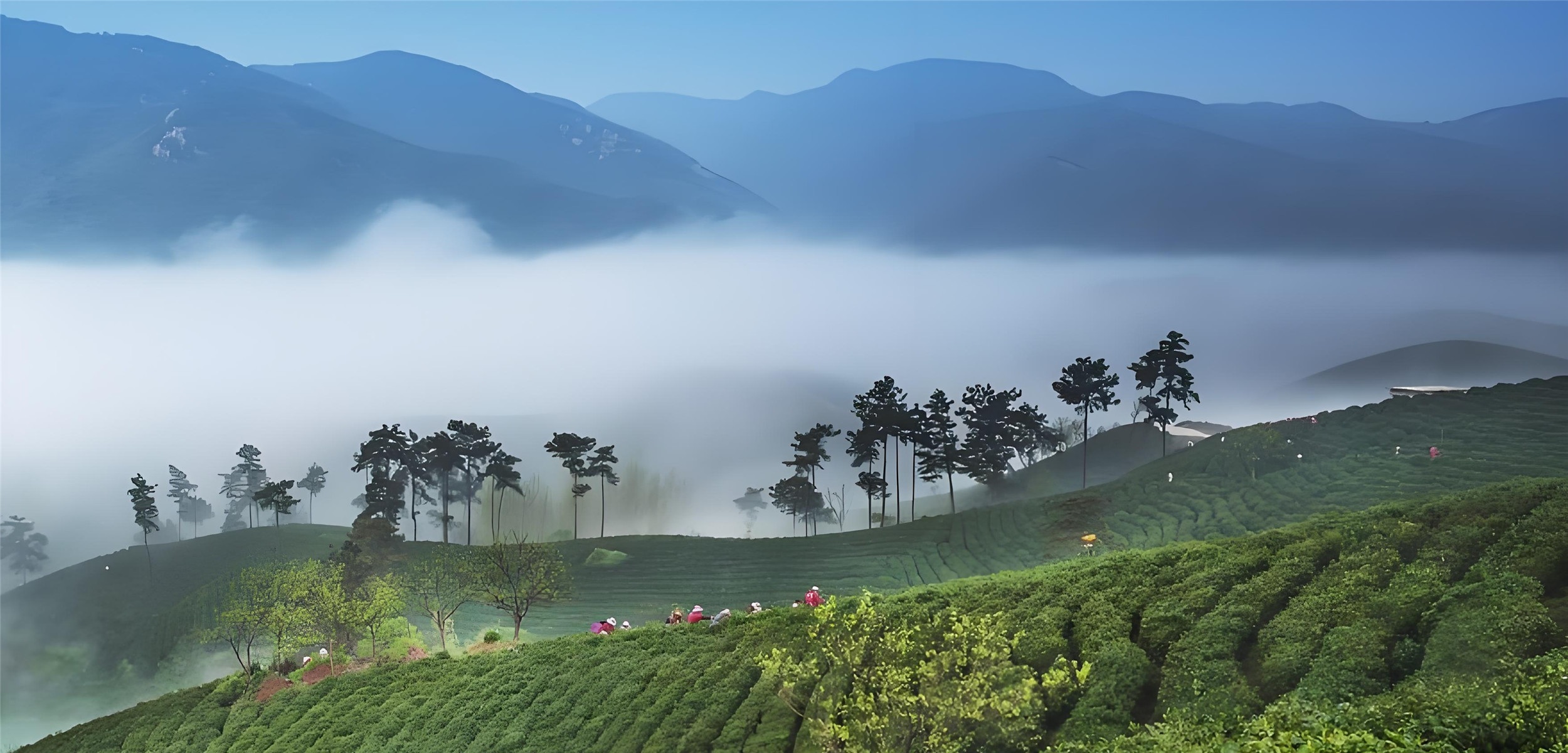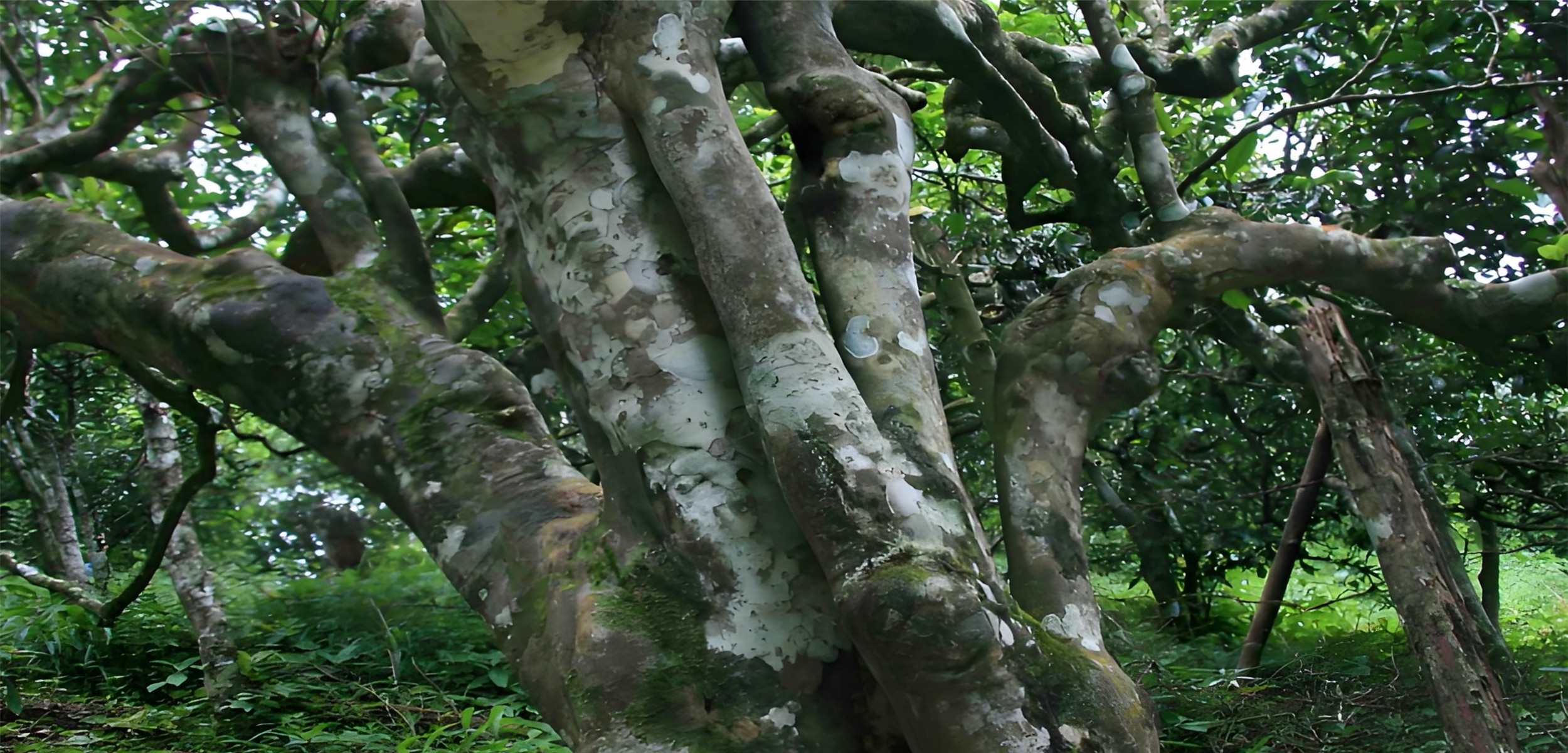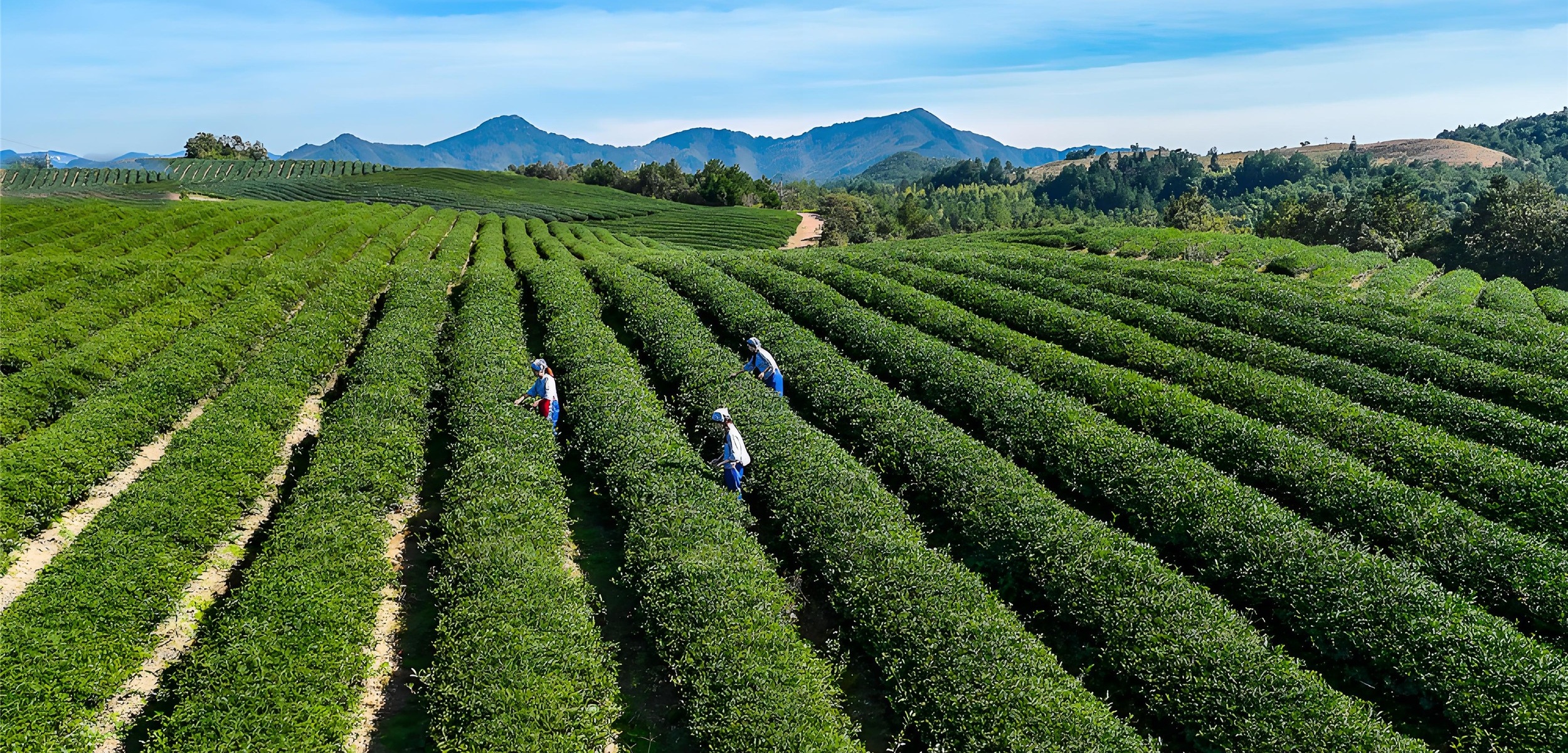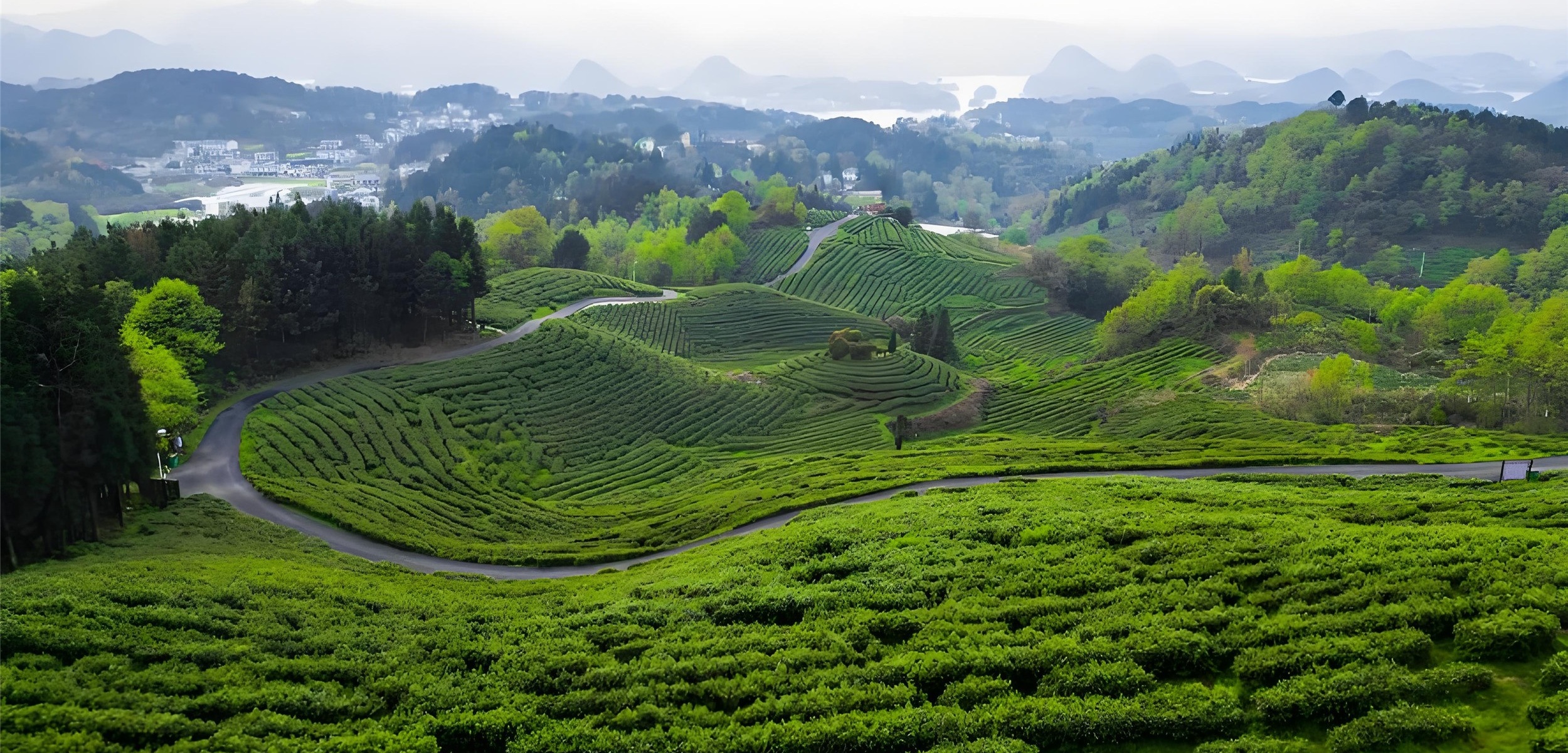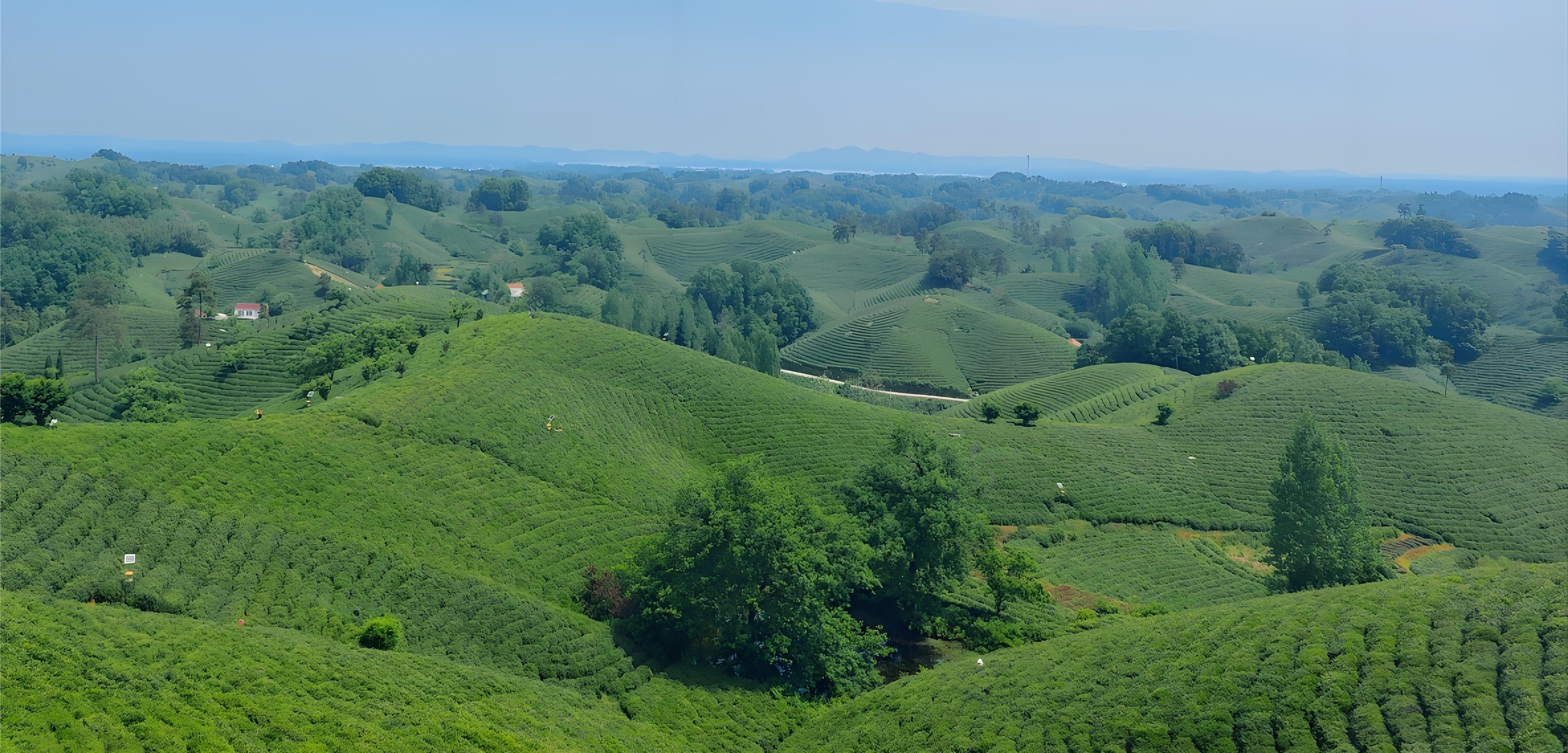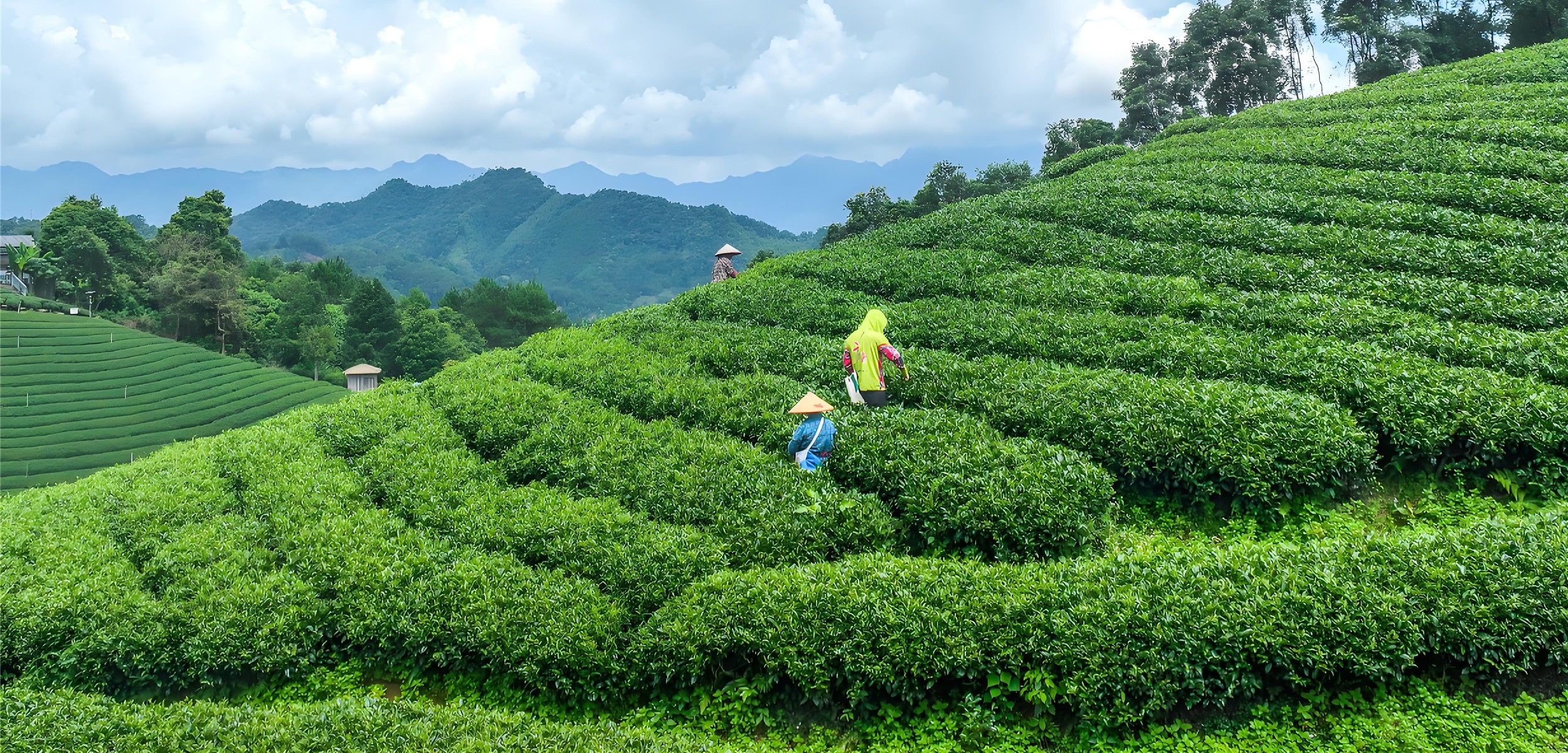探秘云南茶叶:世界茶韵中的瑰宝 云南茶叶的独特魅力 Exploring Yunnan Tea: Treasures of World Tea Charm The Unique Charm of Yunnan Tea

云南,这片被誉为“彩云之南”的神奇土地,以其壮丽的自然风光、丰富的民族文化和独特的地理位置,孕育出了世界闻名的优质茶叶。云南茶叶不仅在中国茶叶市场占据重要地位,更是在国际市场上备受瞩目,成为了中国茶文化走向世界的重要代表。
云南茶叶的魅力首先源自其得天独厚的自然环境。云南地处低纬度高原,气候温暖湿润,阳光充足,雨量充沛,为茶树的生长提供了理想的条件。境内山峦起伏,海拔差异大,从几百米到数千米不等,形成了多样化的生态系统,使得不同品种的茶树能够在各自适宜的环境中茁壮成长。这种独特的地理环境造就了云南茶叶丰富的口感和独特的风味,从清新淡雅的绿茶到醇厚浓郁的普洱茶,从香气馥郁的红茶到独具特色的乌龙茶,每一种茶叶都散发着云南大自然的气息。
云南茶叶的历史源远流长,可追溯到数千年前。据考古发现,云南是世界茶树的起源地之一,拥有大量的野生古茶树资源,这些古茶树见证了云南茶叶的悠久历史。在漫长的岁月里,云南各民族在与茶树的共生中,逐渐形成了独特的茶文化和制茶技艺。这些技艺代代相传,不断发展创新,成为了云南茶叶文化的重要组成部分。无论是传统的普洱茶制作工艺,还是现代的滇红、滇绿制作技术,都蕴含着云南人民的智慧和对茶叶的深厚情感。

云南茶叶的种类与特点
普洱茶
普洱茶是云南最具代表性的茶叶之一,以其独特的发酵工艺和越陈越香的特点而闻名于世。普洱茶分为生茶和熟茶两种。生茶是以云南大叶种晒青毛茶为原料,经过自然陈放,不经过人工“发酵”、“渥堆”处理。生茶的口感清新,汤色黄绿明亮,香气浓郁,具有较强的刺激性。随着时间的推移,生茶中的茶多酚等物质会逐渐发生氧化和聚合反应,汤色会逐渐变红,口感也会变得更加醇厚,香气更加沉稳。熟茶则是在生茶的基础上,经过人工“渥堆”发酵处理,加速茶叶的发酵过程。熟茶的汤色红浓明亮,口感醇厚顺滑,香气独特,具有陈香、枣香等。熟茶的发酵工艺使得茶叶中的刺激性物质得到了充分的转化,对肠胃的刺激性较小,适合大多数人饮用。
普洱茶的魅力不仅在于其独特的口感和香气,还在于其丰富的文化内涵和收藏价值。普洱茶的陈化过程就像是一场时间的艺术,每一片茶叶都承载着岁月的痕迹。优质的普洱茶在陈化过程中,口感和香气会不断发生变化,变得更加醇厚和复杂,因此具有较高的收藏价值。在国际市场上,普洱茶也越来越受到消费者的青睐,成为了中国茶文化的一张亮丽名片。
滇红
滇红是云南红茶的简称,为全发酵茶类。滇红采用云南高山大叶种茶树鲜叶制成,具有独特的品质特点。滇红的外形条索紧结,色泽乌润,金毫显露。其汤色红黄透亮,香气高长,带有独特的果香和蜜香,口感醇厚甜润,回甘持久。滇红的制作工艺严谨,经过萎凋、揉捻、发酵、干燥等多道工序,每一道工序都对茶叶的品质有着重要影响。
滇红根据茶叶的外形和品质可以分为多个品种,其中比较著名的有滇红金针、滇红松针、滇红金芽等。滇红金针通常以一芽鲜叶为原料,造型挺拔如针,汤色红黄透亮,茶汤入口甜滑持久,为滇红中的上品。滇红松针则以一芽一叶初展为原料,茶叶形状如松针,香气高长,口感醇厚。滇红金芽以单芽为原料,芽头肥壮,金毫满披,汤色红亮,香气浓郁,滋味鲜爽。滇红以其独特的品质和口感,在国际市场上赢得了广泛的赞誉,与印度大吉岭红茶、斯里兰卡乌瓦红茶并称为世界三大高香红茶。
滇绿
滇绿即云南绿茶,产于滇南的普洱、西双版纳、红河和滇西南、滇西的临沧、保山、德宏、大理等地区。滇绿一般采摘大叶种一芽二叶开展、一芽三叶初展和同叶质嫩度的单叶、对夹叶鲜叶,经杀青、揉捻、干燥制成毛茶,再经筛分、拣剔、匀堆、复火、撩头割脚、清风、成品装箱包装制成成品茶。
滇绿以大叶种为原料,含有丰富的氨基酸、酚类衍生物、芳香类物质、维生素等。这些物质的综合作用,使得滇绿具有促进消化、降脂减肥、降低血液中的血脂及胆固醇、防止心脑血管疾病、预防流感等功效。滇绿的外形条索紧结,色泽绿润,汤色黄绿明亮,香气清高持久,带有独特的豆香和板栗香,口感鲜爽回甘。滇绿的制作工艺注重保持茶叶的天然色泽和香气,最大程度地保留了茶叶中的营养成分。
云南乌龙茶
云南的乌龙茶多产于腾冲保山、高黎贡山等地。近年来,随着两岸交流不断加深,台湾优良的乌龙茶树品种和先进的制茶技术,在腾冲高山多湿的气候环境和特有的火山灰土条件下得到了极致的发挥。腾冲曾有着活跃的火山群落,其特有的火山灰土,富含磷、钾、钙、镁等矿物质,赋予了腾冲乌龙茶独一无二的香气。
云南乌龙茶的外形卷曲紧结,色泽乌绿油润。其汤色金黄明亮,香气高长,既有乌龙茶特有的花果香,又带有云南茶叶独特的山野气息,口感醇厚鲜爽,回甘生津。常喝乌龙茶,有解毒、消食、去油腻、美容、抗衰老、防癌、提神益思、改善听力、降血脂、减肥等功效。云南乌龙茶以其独特的品质和地域特色,在乌龙茶市场中逐渐崭露头角,受到了越来越多消费者的关注和喜爱。
云南知名茶叶品牌与厂家
大益茶业
大益茶业是普洱茶界的领军企业,其前身为勐海茶厂,始创于1940年。目前已经发展为以普洱茶为核心,贯穿科研、种植、生产、营销与文化全产业链的现代化大型企业集团。大益茶业的产品涵盖了普洱茶的各个领域,包括生茶、熟茶、饼茶、砖茶等。其经典产品“7542”、“7572”等在市场上享有极高的声誉,被誉为普洱茶中的经典之作。“7542”是大益茶业的标杆产品,采用勐海茶区的优质毛茶为原料,经过精心拼配和传统工艺制作而成。其口感醇厚,香气浓郁,具有典型的“勐海味”。“7572”则是大益熟茶的代表产品,以肥壮茶箐为里,幼嫩芽叶为撒面,发酵适度,汤色红浓明亮,口感醇厚顺滑。
大益茶业注重产品品质和创新,拥有先进的生产设备和严格的质量控制体系。其制作工艺已入选国家非物质文化遗产名录,关键技术研配技术与发酵技术,是大益茶品工艺价值之核心,奠定了现代普洱茶发展的格局和基础,为普洱茶行业的发展制定了标准。大益茶业的产品不仅在国内市场广受欢迎,还远销海外多个国家和地区,在国际市场上具有较高的知名度和影响力。
下关沱茶
云南下关沱茶(集团)股份有限公司是一家集茶产品的研发、生产、销售与茶文化传播为一体的茶业企业。下关沱茶创制于1902年,距今已有120多年历史。公司前身为创建于1941年的康藏茶厂,50年代中期改为“云南省下关茶厂”,1994年改制为“云南下关沱茶股份有限公司”,2004年完成民营化改制。经过几代人的艰苦奋斗,现已成为历史底蕴深厚、生产规模大、带动能力强、质量技术优、品牌信誉好、销售网络全的股权多元化、市场国际化的集团公司。
下关沱茶以其独特的工艺和优良的品质闻名于世,其生产的沱茶、砖茶、散茶等深受消费者喜爱。特别是其经典款的下关沱茶更是被誉为“沱茶之王”。下关沱茶的制作工艺独特,采用苍山雪水和优质茶叶为原料,经过选料、拼配、压制等多道工序制作而成。其外形呈碗臼状,紧结端正,色泽乌润,香气清正,口感醇厚,具有独特的陈香和回甘。下关沱茶不仅在国内市场畅销,还出口到日本、韩国、东南亚、欧美等国家和地区,深受国际消费者的喜爱。
澜沧古茶
澜沧古茶品牌历史可追溯至1966年云南景迈山,是一家集研发、生产和销售于一体的综合性茶叶企业。澜沧古茶是“中国茶业百强企业”、“农业产业化国家重点龙头企业”、“云南省普洱茶十大影响力企业”、“云南省食品安全示范单位”,拥有“中国普洱茶十大品牌”、“云南老字号”、“普洱市十大茶叶品牌”等荣誉称号。2023年12月22日,澜沧古茶(HK6911)正式在香港联合交易所主板挂牌上市,成为中国普洱茶IPO第一股,以及主要资本市场上的内地茶企第一股。
澜沧古茶的产品以优质的原料和精湛的工艺著称,其经典产品包含“景迈山古树茶”等。景迈山古树茶生长在景迈山古茶园中,这里的茶树树龄大多在数百年以上,有的甚至上千年。古茶树与森林共生,形成了独特的生态环境,使得茶叶具有独特的香气和口感。景迈山古树茶的外形条索紧结,色泽绿润,香气高长,带有独特的兰花香和蜜香,口感醇厚鲜爽,回甘持久。澜沧古茶注重产品的品质和文化内涵,致力于保护和传承景迈山的茶文化,其产品在国内外市场上都具有较高的知名度和美誉度。
陈升号
成立于2007年的陈升号,经过多年的发展,已经拥有了属于自己的生产基地,致力于打造最优质的普洱茶。如今,陈升号已经成为普洱茶行业的佼佼者,为推动普洱茶产业的发展做出了积极的贡献。陈升号的产品以优质的原料和精湛的工艺著称,其经典产品涵盖“老班章”、“易武正山”等。“老班章”是陈升号的明星产品,选用老班章村的优质古树茶为原料,老班章村的茶叶以其“霸气”的口感而闻名,茶气强劲,回甘迅猛,香气浓郁。陈升号的“老班章”普洱茶在保留了茶叶原有特色的基础上,通过精湛的工艺制作,使得茶叶的口感更加醇厚,香气更加持久。“易武正山”则以易武茶区的茶叶为原料,易武茶区的茶叶以其柔和细腻的口感和独特的香气而受到茶友的喜爱。陈升号的“易武正山”普洱茶口感醇厚,香气清幽,具有典型的易武茶风格。
陈升号注重产品品质和品牌建设,在茶叶的种植、采摘、制作等环节都严格把关。同时,陈升号还积极推广普洱茶文化,通过举办各种茶会和讲座,让更多人了解普洱茶的魅力。其产品不仅在国内市场受到广大茶友的喜爱,在国际市场上也逐渐崭露头角。

云南茶叶在国际市场的地位与发展
历史上的国际交流
云南茶叶在历史上就与国际市场有着密切的联系。早在古代,云南的茶叶就通过“茶马古道”等贸易通道,远销到东南亚、南亚等地。“茶马古道”是一条连接云南、四川、西藏以及东南亚、南亚的古老贸易通道,它不仅促进了茶叶的贸易,还传播了中国的茶文化。在这条古道上,马帮驮着茶叶等物资,穿越崇山峻岭,将云南的茶叶带到了世界各地。云南的普洱茶、滇红等茶叶在东南亚地区尤其受欢迎,成为了当地人们日常生活中不可或缺的饮品。
在近代,随着国际贸易的发展,云南茶叶的出口量不断增加。滇红作为中国红茶的代表之一,在国际市场上赢得了广泛的赞誉。滇红以其独特的香气和口感,与印度大吉岭红茶、斯里兰卡乌瓦红茶并称为世界三大高香红茶,成为了中国茶叶走向世界的重要品牌。
现代国际市场现状
如今,云南茶叶在国际市场上的地位日益重要。普洱茶、滇红、滇绿等茶叶产品远销欧美、日本、韩国、东南亚等国家和地区。在欧美市场,随着人们对健康饮品的追求,普洱茶和滇红的市场份额逐渐扩大。普洱茶因其独特的保健功效,如降脂减肥、降血压、降血脂等,受到了越来越多消费者的关注。滇红则以其浓郁的香气和醇厚的口感,成为了欧美消费者喜爱的红茶品种之一。
在亚洲市场,日本和韩国对云南茶叶的需求也在不断增加。日本消费者对中国茶文化有着浓厚的兴趣,云南的普洱茶、绿茶等产品在日本市场上受到了一定的欢迎。韩国消费者则对滇红的口感较为青睐,滇红在韩国市场上的销量逐年增长。在东南亚市场,云南茶叶一直有着良好的市场基础。普洱茶、滇红等茶叶产品在马来西亚、新加坡、泰国等国家深受消费者喜爱,成为了当地茶叶市场的重要组成部分。
面临的挑战与机遇
云南茶叶在国际市场上虽然取得了一定的成绩,但也面临着一些挑战。首先,国际市场上茶叶品牌众多,竞争激烈。印度、斯里兰卡等国家的茶叶在国际市场上已经占据了一定的份额,云南茶叶需要在品牌建设和市场推广方面加大力度,提高品牌知名度和市场竞争力。其次,不同国家和地区对茶叶的质量标准和检测要求不同,云南茶叶企业需要加强质量管理,提高产品质量,以满足国际市场的需求。此外,贸易壁垒、汇率波动等因素也会对云南茶叶的出口产生一定的影响。
然而,云南茶叶在国际市场上也面临着许多机遇。随着全球经济的发展和人们生活水平的提高,消费者对健康饮品的需求不断增加,茶叶作为一种天然的健康饮品,市场前景广阔。云南茶叶以其独特的品质和丰富的文化内涵,具有很大的发展潜力。同时,随着“一带一路”倡议的推进,云南作为中国面向南亚东南亚的辐射中心,茶叶贸易的通道更加畅通,为云南茶叶走向国际市场提供了更加有利的条件。此外,互联网技术的发展也为云南茶叶的国际营销提供了新的渠道和平台,通过电商平台,云南茶叶可以更加便捷地进入国际市场,拓展销售渠道。

如何品鉴云南茶叶
观外形
品鉴云南茶叶,首先要观察茶叶的外形。不同种类的茶叶外形各具特点。普洱茶的生茶外形条索肥壮紧结,色泽墨绿油润,白毫显露;熟茶外形条索紧实,色泽褐红。滇红的外形条索紧结,色泽乌润,金毫显露。滇绿的外形条索紧结,色泽绿润。云南乌龙茶的外形卷曲紧结,色泽乌绿油润。观察茶叶外形时,要注意茶叶的条索是否匀整,色泽是否鲜活,有无杂质等。优质的茶叶外形应该匀整美观,色泽自然。
闻香气
闻香气是品鉴茶叶的重要环节。将干茶放在鼻下轻轻嗅闻,感受茶叶的干香。普洱茶生茶的干香通常带有清新的花香、果香或蜜香,熟茶则带有独特的陈香、枣香或樟香。滇红的干香浓郁,带有果香和蜜香。滇绿的干香清高,带有豆香和板栗香。云南乌龙茶的干香高长,带有花果香和山野气息。
泡茶后,闻茶汤的香气。香气应该持久、纯正、浓郁。普洱茶生茶的茶汤香气清新高扬,熟茶的茶汤香气醇厚沉稳。滇红的茶汤香气浓郁甜润,滇绿的茶汤香气清新爽口,云南乌龙茶的茶汤香气高长鲜爽。此外,还可以闻叶底的香气,叶底香气应该与茶汤香气一致,且持久不散。
品滋味
品滋味是品鉴茶叶的关键环节。将茶汤含在口中,用舌头充分感受茶汤的滋味。普洱茶生茶的口感清新,茶汤醇厚,回甘生津,具有较强的刺激性;熟茶的口感醇厚顺滑,茶汤甜润,回甘持久,对肠胃的刺激性较小。滇红的口感醇厚甜润,茶汤入口即化,回甘持久,带有独特的果香和蜜香。滇绿的口感鲜爽回甘,茶汤清爽,带有豆香和板栗香。云南乌龙茶的口感醇厚鲜爽,茶汤饱满,回甘生津,既有乌龙茶特有的花果香,又带有云南茶叶独特的山野气息。
在品滋味时,要注意茶汤的浓度、甜度、酸度、苦涩度等。优质的茶叶茶汤应该浓度适中,甜度自然,酸度适宜,苦涩度协调,回甘生津明显。
看汤色
看汤色也是品鉴茶叶的重要内容。将冲泡好的茶汤倒入透明的玻璃杯中,观察汤色。普洱茶生茶的汤色黄绿明亮,随着陈化时间的增加,汤色会逐渐变红;熟茶的汤色红浓明亮。滇红的汤色红黄透亮。滇绿的汤色黄绿明亮。云南乌龙茶的汤色金黄明亮。汤色应该清澈透明,无浑浊和杂质。优质的茶叶汤色应该鲜艳明亮,给人以视觉上的享受。

云南茶叶的未来展望
云南茶叶凭借其独特的自然环境、悠久的历史文化和丰富的品种资源,在国际市场上具有广阔的发展前景。未来,云南茶叶产业应加强科技创新,提高茶叶的品质和产量。通过研发新的种植技术、制茶工艺和保鲜技术,提升云南茶叶的市场竞争力。同时,要加强品牌建设,打造更多具有国际影响力的茶叶品牌。通过品牌营销和文化传播,让更多的国际消费者了解云南茶叶的魅力。
在市场拓展方面,云南茶叶企业应积极开拓国际市场,加强与国际茶叶企业的合作与交流。利用“一带一路”倡议的机遇,加强与沿线国家和地区的茶叶贸易,拓展销售渠道。此外,还应关注国际市场的需求变化,开发适合不同国家和地区消费者口味。

Yunnan, this magical land known as the "South of Colorful Clouds", has nurtured world-renowned high-quality tea with its magnificent natural scenery, rich ethnic culture, and unique geographical location. Yunnan tea not only occupies an important position in the Chinese tea market, but also attracts attention in the international market, becoming an important representative of Chinese tea culture going global.
The charm of Yunnan tea first comes from its unique natural environment. Yunnan is located on a low latitude plateau, with a warm and humid climate, abundant sunshine, and abundant rainfall, providing ideal conditions for the growth of tea trees. The mountains within the territory are undulating and the altitude varies greatly, ranging from hundreds to thousands of meters, forming a diverse ecosystem that enables different varieties of tea trees to grow vigorously in their respective suitable environments. This unique geographical environment has created a rich taste and distinctive flavor of Yunnan tea, from fresh and elegant green tea to mellow and rich Pu'er tea, from fragrant black tea to unique oolong tea, each type of tea exudes the natural atmosphere of Yunnan.
The history of Yunnan tea has a long and profound history, dating back thousands of years. According to archaeological discoveries, Yunnan is one of the origins of tea trees in the world, with a large amount of wild ancient tea tree resources. These ancient tea trees bear witness to the long history of Yunnan tea. Over the long years, various ethnic groups in Yunnan have gradually developed unique tea cultures and tea making techniques through their symbiotic relationship with tea trees. These skills have been passed down from generation to generation, constantly developing and innovating, and have become an important part of Yunnan tea culture. Whether it is the traditional Pu'er tea making process or the modern Yunnan red and Yunnan green making techniques, they all contain the wisdom and deep emotions of the Yunnan people towards tea.
Types and characteristics of Yunnan tea
Pu'er tea
Pu'er tea is one of the most representative teas in Yunnan, renowned for its unique fermentation process and the characteristic of becoming more fragrant with age. Pu erh tea is divided into two types: raw tea and ripe tea. Raw tea is made from Yunnan large leaf sun dried green tea as raw material, which is naturally aged without artificial "fermentation" or "piling" treatment. The taste of raw tea is fresh, the soup color is bright yellow green, the aroma is rich, and it has strong stimulation. Over time, substances such as tea polyphenols in raw tea will gradually undergo oxidation and polymerization reactions, causing the soup color to gradually turn red, the taste to become richer, and the aroma to become more stable. Mature tea is processed through artificial "pile" fermentation on the basis of raw tea, accelerating the fermentation process of tea leaves. The soup color of ripe tea is red, thick, and bright, with a mellow and smooth taste and unique aroma, including aged and jujube aromas. The fermentation process of ripe tea allows the stimulating substances in the tea leaves to be fully converted, resulting in less irritation to the stomach and intestines, making it suitable for most people to drink.
The charm of Pu'er tea lies not only in its unique taste and aroma, but also in its rich cultural connotations and collectible value. The aging process of Pu'er tea is like an art of time, with each leaf bearing the traces of time. High quality Pu'er tea undergoes continuous changes in taste and aroma during the aging process, becoming more mellow and complex, making it highly valuable for collection. In the international market, Pu'er tea is increasingly favored by consumers and has become a shining business card of Chinese tea culture.
Dianhong
Dianhong is the abbreviation for Yunnan black tea, which is a fully fermented tea. Dianhong is made from fresh leaves of Yunnan high-altitude large leaf tea trees and has unique quality characteristics. The appearance of Dian Hong is tightly tied, with a dark and smooth color, and golden hair exposed. Its soup has a bright red yellow color, a high and long-lasting aroma, with unique fruit and honey aromas, a mellow and sweet taste, and a long-lasting aftertaste. The production process of Dianhong tea is rigorous, involving multiple steps such as withering, rolling, fermentation, and drying, each of which has a significant impact on the quality of the tea leaves.
Dian Hong tea can be divided into multiple varieties based on its appearance and quality, among which the more famous ones are Dian Hong Jin Zhen, Dian Hong Song Zhen, Dian Hong Jin Ya, etc. Dian Hong Jin Zhen is usually made from a single fresh leaf as raw material, with a straight and upright shape like a needle, a bright red yellow soup color, and a long-lasting sweet and smooth tea soup. It is the top grade among Dian Hong teas. Dian Hong Song needle is made from the initial development of one bud and one leaf, with tea leaves shaped like pine needles, high and long aroma, and rich taste. Dianhong Jinya is made from single buds, with plump buds and golden hairs covering the surface. The soup color is bright red, the aroma is rich, and the taste is fresh and refreshing. Dian Hong has won wide acclaim in the international market for its unique quality and taste, and is known as one of the world's three high aroma black teas along with Indian Darjeeling black tea and Sri Lankan Uva black tea.
Dian Green
Dian green tea, also known as Yunnan green tea, is produced in Pu'er, Xishuangbanna, Honghe in southern Yunnan, as well as in Lincang, Baoshan, Dehong, Dali and other areas in southwestern and western Yunnan. Dian Lv generally picks large leaf seeds with one bud and two leaves for development, one bud and three leaves for initial development, and single leaves with the same leaf quality and tenderness, as well as fresh leaves with mixed leaves. After withering, rolling, and drying, it is made into hairy tea, which is then screened, picked, evenly stacked, reheated, peeled, and packaged into finished tea products.
Dian green is made from large leaf species and contains abundant amino acids, phenolic derivatives, aromatic substances, vitamins, etc. The comprehensive effect of these substances makes Dian green have the functions of promoting digestion, reducing cholesterol and cholesterol, lowering blood lipids and cholesterol in the blood, preventing cardiovascular and cerebrovascular diseases, and preventing influenza. The appearance of Dian green is tightly tied, the color is green and moist, the soup color is bright yellow green, the aroma is clear and long-lasting, with unique bean and chestnut aromas, and the taste is fresh and refreshing with a sweet aftertaste. The production process of Dian Lv focuses on maintaining the natural color and aroma of tea leaves, while maximizing the preservation of the nutritional components in tea leaves.
Yunnan Oolong Tea
Oolong tea in Yunnan is mostly produced in areas such as Tengchong Baoshan and Gaoligong Mountain. In recent years, with the deepening of cross-strait exchanges, Taiwan's excellent oolong tea tree varieties and advanced tea making techniques have been fully utilized in the humid climate environment and unique volcanic ash soil conditions of Tengchong Mountain. Tengchong once had an active volcanic community, with its unique volcanic ash soil rich in minerals such as phosphorus, potassium, calcium, and magnesium, giving Tengchong oolong tea a unique aroma.
The appearance of Yunnan oolong tea is curly and tight, with a dark green and oily color. Its soup has a bright golden yellow color and a long-lasting aroma, combining the unique floral and fruity aroma of oolong tea with the unique mountain and wild flavor of Yunnan tea. It has a rich and refreshing taste, with a sweet and refreshing aftertaste. Drinking oolong tea regularly has the effects of detoxification, digestion, reducing greasiness, beauty, anti-aging, cancer prevention, refreshing and thinking, improving hearing, lowering blood lipids, and weight loss. Yunnan oolong tea, with its unique quality and regional characteristics, has gradually emerged in the oolong tea market and received increasing attention and love from consumers.
Famous tea brands and manufacturers in Yunnan
Dayi Tea Industry
Dayi Tea Industry is a leading enterprise in the Pu'er tea industry, formerly known as Menghai Tea Factory, founded in 1940. At present, it has developed into a modern large-scale enterprise group with Pu'er tea as its core, running through the entire industry chain of scientific research, planting, production, marketing, and culture. Dayi Tea Industry's products cover various fields of Pu'er tea, including raw tea, ripe tea, cake tea, brick tea, etc. Its classic products such as "7542" and "7572" enjoy a high reputation in the market and are hailed as classic works of Pu'er tea. 7542 "is a benchmark product of Dayi Tea Industry, made from high-quality raw tea from Menghai Tea District, carefully blended and processed using traditional techniques. Its taste is mellow, with a rich aroma and a typical "Menghai flavor". 7572 "is a representative product of Da Yi ripe tea, with fat tea leaves as the inner layer and tender buds and leaves as the spreading surface. The fermentation is moderate, and the soup color is red, thick, bright, and the taste is mellow and smooth.
Dayi Tea Industry focuses on product quality and innovation, with advanced production equipment and strict quality control system. Its production process has been included in the National Intangible Cultural Heritage List, and the key technology research and fermentation technology is the core of the technological value of Dayi tea products, laying the pattern and foundation for the development of modern Pu'er tea and setting standards for the development of the Pu'er tea industry. The products of Dayi Tea Industry are not only widely popular in the domestic market, but also exported to multiple countries and regions overseas, and have a high level of popularity and influence in the international market.
Xiaguan Tuocha
Yunnan Xiaguantuo Tea (Group) Co., Ltd. is a tea industry enterprise that integrates research and development, production, sales, and tea culture dissemination of tea products. Xiaguantuo tea was created in 1902 and has a history of over 120 years. The company was formerly known as Kangzang Tea Factory, founded in 1941. In the mid-1950s, it was renamed as "Yunnan Xiaguan Tea Factory". In 1994, it was restructured as "Yunnan Xiaguan Tuo Tea Co., Ltd." and completed privatization in 2004. After several generations of hard work, it has become a group company with a profound historical background, large production scale, strong driving ability, excellent quality and technology, good brand reputation, complete sales network, diversified equity, and international market.
Xiaguan Tuocha is renowned for its unique craftsmanship and excellent quality, and its produced Tuocha, brick tea, loose tea, etc. are deeply loved by consumers. Especially its classic Xiaguan Tuo tea is known as the "king of Tuo tea". The production process of Xiaguantuo tea is unique, using Cangshan snow water and high-quality tea leaves as raw materials, through multiple processes such as material selection, blending, and pressing. Its appearance is bowl shaped, tightly tied and upright, with a dark and smooth color, a clear aroma, a mellow taste, and a unique aged and sweet aftertaste. Xiaguantuo tea is not only popular in the domestic market, but also exported to countries and regions such as Japan, South Korea, Southeast Asia, Europe, and America, and is deeply loved by international consumers.
Lancang Ancient Tea
The history of Lancang Ancient Tea brand can be traced back to 1966 in Jingmai Mountain, Yunnan. It is a comprehensive tea enterprise that integrates research and development, production, and sales. Lancang Ancient Tea is one of the "Top 100 Enterprises in China's Tea Industry", "National Key Leading Enterprise in Agricultural Industrialization", "Top 10 Influential Enterprises of Pu'er Tea in Yunnan Province", "Demonstration Unit of Food Safety in Yunnan Province", and has honorary titles such as "Top 10 Brands of Pu'er Tea in China", "Yunnan Time honored Brand", and "Top 10 Tea Brands in Pu'er City". On December 22, 2023, Lancang Ancient Tea (HK6911) was officially listed on the main board of the Hong Kong Stock Exchange, becoming the first IPO of Chinese Pu erh tea and the first mainland tea enterprise on major capital markets.
The products of Lancang Ancient Tea are renowned for their high-quality raw materials and exquisite craftsmanship, including classic products such as "Jingmai Mountain Ancient Tree Tea". Jingmai Mountain Ancient Tree Tea grows in the Jingmai Mountain Ancient Tea Garden, where most of the tea trees are over hundreds of years old, some even thousands of years old. The coexistence of ancient tea trees and forests has formed a unique ecological environment, giving tea leaves a unique aroma and taste. The appearance of Jingmai Mountain ancient tree tea is tightly tied, with a green and moist color, a high and long aroma, and unique orchid and honey aromas. The taste is mellow, fresh, and refreshing, with a long-lasting aftertaste. Lancang Ancient Tea focuses on the quality and cultural connotation of its products, and is committed to protecting and inheriting the tea culture of Jingmai Mountain. Its products have a high level of popularity and reputation in both domestic and international markets.
Chen Shenghao
Established in 2007, Chensheng Tea has developed over the years and now has its own production base, dedicated to creating the highest quality Pu'er tea. Nowadays, Chen Shenghao has become a leader in the Pu'er tea industry and has made positive contributions to promoting the development of the Pu'er tea industry. Chen Sheng's products are renowned for their high-quality raw materials and exquisite craftsmanship, with classic products including "Lao Ban Zhang" and "Yi Wu Zheng Shan". Laobanzhang "is a star product of Chen Sheng Hao, using high-quality ancient tree tea from Laobanzhang Village as raw material. Laobanzhang Village's tea is famous for its" domineering "taste, strong tea aroma, rapid aftertaste, and rich aroma. Chen Sheng's "Lao Ban Zhang" Pu erh tea retains the original characteristics of the tea leaves, and through exquisite craftsmanship, makes the taste of the tea more mellow and the aroma more long-lasting. Yiwu Zhengshan "is made from tea leaves from Yiwu tea area, which are loved by tea lovers for their soft and delicate taste and unique aroma. Chen Sheng's "Yiwu Zhengshan" Pu'er tea has a rich and mellow taste, with a subtle aroma and a typical Yiwu tea style.
Chen Shenghao pays attention to product quality and brand building, and strictly controls the planting, picking, and production of tea leaves. At the same time, Chen Shenghao actively promotes Pu'er tea culture by holding various tea parties and lectures to let more people understand the charm of Pu'er tea. Its products are not only loved by tea enthusiasts in the domestic market, but also gradually emerging in the international market.
The Status and Development of Yunnan Tea in the International Market
International exchanges in history
Yunnan tea has had close ties with the international market throughout history. As early as ancient times, Yunnan's tea was exported to Southeast Asia, South Asia and other places through trade channels such as the "Tea Horse Ancient Road". The "Ancient Tea Horse Road" is an ancient trade channel connecting Yunnan, Sichuan, Xizang, Southeast Asia and South Asia. It not only promotes tea trade, but also spreads Chinese tea culture. On this ancient road, the caravan carried tea and other supplies, crossed the mountains and brought Yunnan's tea to various parts of the world. Yunnan's Pu'er tea, Dianhong tea and other tea leaves are particularly popular in Southeast Asia and have become indispensable drinks in the daily lives of local people.
In modern times, with the development of international trade, the export volume of Yunnan tea has been continuously increasing. Dian Hong, as one of the representatives of Chinese black tea, has won wide acclaim in the international market. Dian Hong, with its unique aroma and taste, is known as one of the world's three high aroma black teas along with Indian Darjeeling black tea and Sri Lankan Uva black tea, becoming an important brand for Chinese tea to go global.
Current situation of modern international market
Nowadays, Yunnan tea's position in the international market is becoming increasingly important. Pu'er tea, Dianhong tea, Dianlv tea and other tea products are exported to countries and regions such as Europe, America, Japan, South Korea, Southeast Asia, etc. In the European and American markets, with people's pursuit of healthy drinks, the market share of Pu'er tea and Dianhong tea is gradually expanding. Pu'er tea has attracted increasing attention from consumers due to its unique health benefits, such as lipid-lowering and weight loss, blood pressure lowering, and blood lipid lowering. Dian Hong, with its rich aroma and mellow taste, has become one of the popular red tea varieties among European and American consumers.
In the Asian market, the demand for Yunnan tea from Japan and South Korea is also constantly increasing. Japanese consumers have a strong interest in Chinese tea culture, and Yunnan's Pu'er tea, green tea, and other products have been well received in the Japanese market. Korean consumers prefer the taste of Dianhong, and its sales in the Korean market have been increasing year by year. In the Southeast Asian market, Yunnan tea has always had a good market foundation. Pu erh tea, Dian hong tea and other tea products are deeply loved by consumers in countries such as Malaysia, Singapore, and Thailand, and have become an important part of the local tea market.
Challenges and opportunities faced
Although Yunnan tea has achieved certain results in the international market, it also faces some challenges. Firstly, there are numerous tea brands in the international market with fierce competition. Tea from countries such as India and Sri Lanka has already occupied a certain share in the international market. Yunnan tea needs to increase its efforts in brand building and market promotion to enhance brand awareness and market competitiveness. Secondly, different countries and regions have different quality standards and testing requirements for tea. Yunnan tea enterprises need to strengthen quality management and improve product quality to meet the needs of the international market. In addition, factors such as trade barriers and exchange rate fluctuations can also have a certain impact on the export of Yunnan tea.
However, Yunnan tea also faces many opportunities in the international market. With the development of the global economy and the improvement of people's living standards, consumers' demand for healthy drinks continues to increase. As a natural health drink, tea has a broad market prospect. Yunnan tea has great potential for development due to its unique quality and rich cultural connotations. At the same time, with the promotion of the "the Belt and Road" initiative, Yunnan, as China's radiation center facing South Asia and Southeast Asia, has a more open channel for tea trade, providing more favorable conditions for Yunnan tea to enter the international market. In addition, the development of Internet technology also provides new channels and platforms for the international marketing of Yunnan tea. Through e-commerce platforms, Yunnan tea can enter the international market more easily and expand sales channels.
How to taste Yunnan tea
Observing appearance
To taste Yunnan tea, the first thing to observe is the appearance of the tea leaves. Different types of tea have their own characteristics in appearance. The raw tea of Pu'er tea has a plump and tight appearance, with a dark green and oily color, and white hairs exposed; The ripe tea has a tight and compact appearance, with a brownish red color. The appearance of Dian Hong is tightly tied, with a dark and smooth color, and golden hair exposed. The appearance of Dian green is tightly tied and the color is green and moist. The appearance of Yunnan oolong tea is curly and tight, with a dark green and oily color. When observing the appearance of tea leaves, attention should be paid to whether the tea leaves have uniform strands, fresh color, and impurities. High quality tea should have a uniform and beautiful appearance, with a natural color.
Smell the fragrance
Smelling the aroma is an important part of tasting tea. Gently sniff the dried tea under your nose and feel the dry aroma of the tea leaves. The dry aroma of raw Pu erh tea usually carries a fresh floral, fruity, or honey fragrance, while ripe tea has a unique aged, jujube, or camphor aroma. Dianhong has a rich dry aroma with fruity and honey notes. The dry fragrance of Yunnan green is clear and high, with bean and chestnut aromas. Yunnan oolong tea has a long and dry aroma, with floral and fruity notes as well as a wild mountain flavor.
After brewing tea, smell the aroma of the tea soup. The aroma should be long-lasting, pure, and rich. The aroma of raw Pu erh tea is fresh and high, while the aroma of ripe tea is mellow and steady. The tea soup of Yunnan red has a rich and sweet aroma, the tea soup of Yunnan green has a fresh and refreshing aroma, and the tea soup of Yunnan oolong tea has a high, long-lasting, and fresh aroma. In addition, you can also smell the aroma at the bottom of the leaves, which should be consistent with the aroma of the tea soup and long-lasting.
Taste Taste
Tasting is a crucial step in appreciating tea. Take the tea soup in your mouth and use your tongue to fully feel the taste of the tea soup. Pu erh tea has a fresh taste, a rich and mellow tea soup, a sweet and refreshing aftertaste, and strong stimulating properties; The taste of ripe tea is mellow and smooth, the tea soup is sweet and mellow, with a long-lasting aftertaste and minimal irritation to the digestive system. Dianhong tea has a rich and sweet taste, with a tea soup that melts in the mouth, a long-lasting aftertaste, and a unique fruity and honey aroma. The taste of Yunnan green is fresh and refreshing, with a sweet aftertaste, and the tea soup is refreshing with bean and chestnut aromas. The taste of Yunnan oolong tea is mellow, fresh, and refreshing, with a full tea soup and a sweet and refreshing aftertaste. It not only has the unique floral and fruity aroma of oolong tea, but also has the unique mountain and wild flavor of Yunnan tea.
When tasting tea, attention should be paid to the concentration, sweetness, acidity, bitterness, etc. of the tea soup. High quality tea soup should have a moderate concentration, natural sweetness, appropriate acidity, balanced bitterness, and a clear aftertaste and production of saliva.
Look at the color of the soup
Observing the color of the soup is also an important aspect of tasting tea. Pour the brewed tea into a transparent glass and observe the color of the soup. The soup color of raw Pu erh tea is bright yellow green, and as the aging time increases, the soup color will gradually turn red; The soup color of ripe tea is red, thick, and bright. Dian Hong's soup has a bright red yellow color. The soup color of Yunnan green is bright yellow green. The soup color of Yunnan oolong tea is bright golden yellow. The soup color should be clear and transparent, without turbidity or impurities. High quality tea soup should have bright and vibrant colors, giving people a visual enjoyment.
Future prospects of Yunnan tea
Yunnan tea has broad development prospects in the international market due to its unique natural environment, long history and culture, and abundant variety resources. In the future, Yunnan's tea industry should strengthen technological innovation to improve the quality and yield of tea. By developing new planting techniques, tea making processes, and preservation techniques, we aim to enhance the market competitiveness of Yunnan tea. At the same time, we need to strengthen brand building and create more tea brands with international influence. Through brand marketing and cultural dissemination, let more international consumers understand the charm of Yunnan tea.
In terms of market expansion, Yunnan tea enterprises should actively explore international markets and strengthen cooperation and exchanges with international tea enterprises. Take the opportunity of the "the Belt and Road" initiative to strengthen tea trade with countries and regions along the line and expand sales channels. In addition, attention should be paid to changes in international market demand and the development of flavors suitable for consumers in different countries and regions.

